Profit And Loss Adjustment Account Format
Use Vyapar’s profit and loss adjustment account format to record the transactions left while preparing the balance sheet. Use the Vyapar app to manage all your accounting requirements in one place. Get your 7-day free trial now!
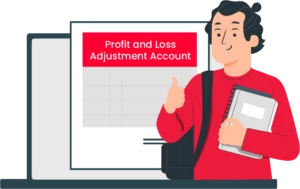
Download Profit And Loss Adjustment Account Format in Excel
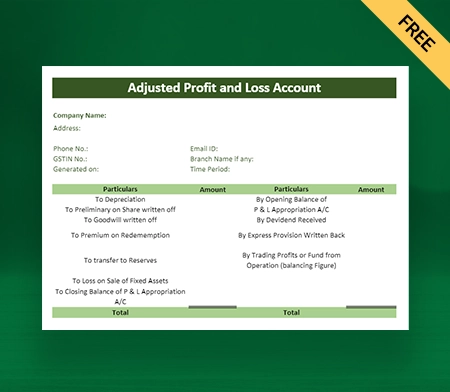
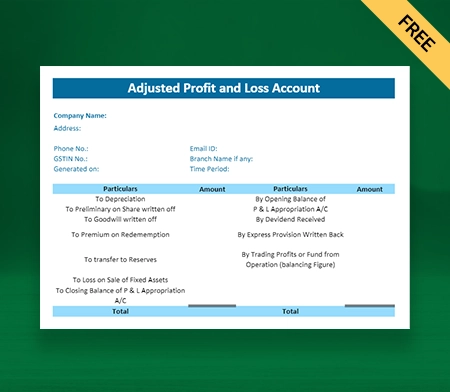
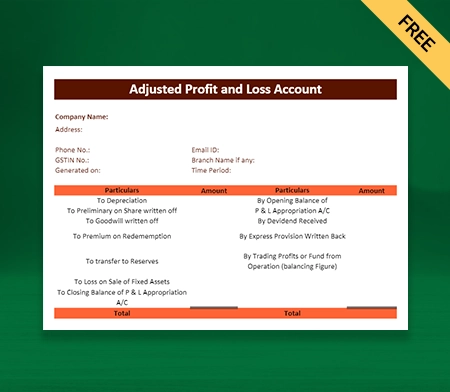
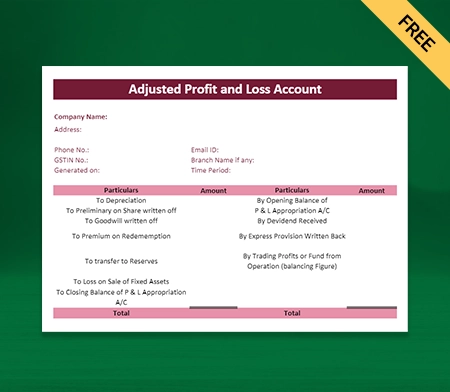
What Is The Profit And Loss Adjustment Account?
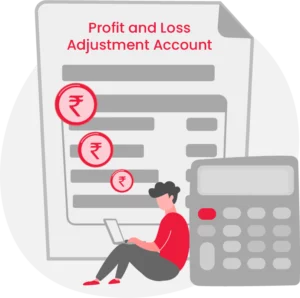
A profit and loss adjustment account format is prepared to record the transactions left while preparing the balance sheet. The omission can be about interest on capital, interest on drawings, interest on partners’ loans, partner’s salary, commission, or outstanding expenses.
The profit and loss adjustment account, also known as the P&L adjustment or the income summary account, is a temporary account used in accounting to adjust a business’s net income or loss. It is commonly used to close the books at the end of an accounting period.
The purpose of the profit and loss adjustment account format is to transfer the balances of revenue and expense accounts to the appropriate capital accounts or retained earnings accounts. It ensures that the income and expenses for a particular period are properly accounted for and reflected in the financial statements.
How Does The Profit And Loss Adjustment Account Work?

1. Revenue And Expense Accounts:
During an accounting period, revenue accounts (such as sales and service income) record the income generated, while expense accounts (such as salaries, rent, and utilities) record the costs incurred by the business.
2. Calculation Of Net Income Or Loss:
At the end of the accounting period, the revenue and expense accounts are totalled. The revenue total is subtracted from the expense total to determine the net income or loss for the period.
3. Transfer To The Profit And Loss Adjustment Account:
The net income or loss is transferred to the profit and loss adjustment account.
4. Closing Entries:
After the transfer, the revenue and expense accounts are closed to zero by transferring their balances to the profit and loss adjustment account. This process resets the revenue and expense accounts for the next accounting period.
5. Transfer To Capital Or Retained Earnings:
The balance in the profit and loss adjustment account format is transferred to the capital accounts or retained earnings accounts. This reflects the cumulative profit or loss of the business over time.
By using the profit and loss adjustment account, a business can clearly separate the revenue and expense accounts from the capital accounts or retained earnings accounts.
Why Are Adjustments Necessary In The Profit And Loss Account Format?
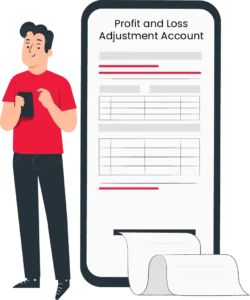
Adjustments Are Necessary For The Profit And Loss Account Format For Several Reasons:
Accurate Financial Reporting:
The primary purpose of the profit and loss account is to report the financial performance of a company over a specific period. Adjustments ensure that the reported revenue and expenses are accurate and reflect the true financial position of the business. They help correct any errors or omissions in the initial recording of transactions.
Matching Principle:
The matching principle is a fundamental accounting concept that requires expenses to be matched with the revenues they generate in the same accounting period. Adjustments help make sure that all relevant revenues and expenses are properly matched.
Revenue Recognition:
Adjustments may be needed to recognise revenue in the appropriate accounting period. For example, if a company provides services but has not yet invoiced the customer, an adjustment is made to recognise the revenue in the period when the services were performed rather than when the cash is received.
Expense Allocation:
Adjustments are used to allocate expenses accurately across accounting periods. For example, prepaid expenses or unearned revenues may need to be adjusted to reflect the portion applicable to the current period. Similarly, accrued expenses or revenues may require adjustments to recognise the portion related to the current period.
Compliance With Accounting Standards:
Adjustments are necessary to ensure compliance with accounting standards. The standards provide guidelines on revenue recognition, expense matching, and other accounting principles that require adjustments for accurate financial reporting.
Correcting Errors And Irregularities:
Adjustments are crucial for rectifying errors, omissions, or irregularities in financial statements. They help identify and correct any inaccuracies in recording revenue or expenses. It ensures that the financial statements provide a true and fair view of the company’s financial performance.
Benefits Of Using Vyapar Profit And Loss Adjustment Account Format
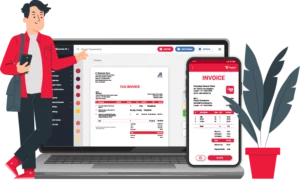
Clear Presentation:
The profit and loss adjustment account format provides separate sections or categories to record different types of adjustments. This segregation allows for a clear presentation of each adjustment. It ensures that they are not mixed up with regular income or expenses.
The Vyapar account format follows a standardised structure that facilitates a systematic presentation of the profit and loss adjustments. It includes headings, subheadings, and clear labels for each adjustment category.
The use of a standardised format ensures consistency in the presentation of profit and loss adjustments across different periods or financial statements. The consistency helps readers easily compare and analyse the adjustments.
Accurate Calculations:
Every adjustment in the Vyapar profit and loss adjustment account format has the proper classification and label. It makes its function and character clear. Applying the appropriate formula or calculation method for each adjustment becomes this categorisation. It makes sure that computations are done correctly.
Subtotals and totals are included in the Vyapar format at many levels, including those for specific adjustment categories and overall profit and loss adjustments. The underlying data is used to produce these subtotals and totals.
In order to determine the values for various changes, the profit and loss adjustment account format encourages the use of mathematical calculations. Each type of adjustment-specific formula, equation, or fixed calculation technique is used.
Comparative Analysis:
The consistency of Vyapar formats enables easy comparison between different periods, companies, or business units. It provides a summarised view of the adjustments, which makes it easier to compare the magnitude and impact of adjustments between different periods or entities.
You can perform variance analysis on profit and loss adjustments. This involves comparing the actual adjustments with the expected or budgeted adjustments. The format’s clear presentation and consistent structure allow you to understand the reasons behind deviations and take appropriate action.
The profit and loss adjustment account format’s consistent presentation and structured organisation enable trend analysis of profit and loss adjustments over time. By comparing adjustments across multiple periods, you can identify patterns, changes, or trends in specific categories.
Better Decision Making:
The profit and loss adjustment account format provides a comprehensive view of profit and loss adjustments. It allows you to understand the financial impact of various adjustments on the business’s profitability. It becomes easy to analyse and interpret financial information.
The Vyapar format helps in identifying key profit and loss adjustments that have a significant impact on the financial statements. By categorising and organising adjustments, it highlights the adjustments that have a substantial effect.
The format presents adjustments separately from regular income and expenses. It provides a clearer picture of the true financial performance of the business. You can analyse the patterns and changes in adjustments to identify trends and make forecasts.
Mobile Accessibility:
With mobile accessibility, users can receive real-time updates and make instant changes or additions to the Vyapar format directly from their mobile devices. Users can input data, modify figures, or include new adjustments on the go without having to wait until they are back at their computers.
Mobile accessibility allows for seamless collaboration and sharing of the Vyapar profit and loss adjustment account format with team members, stakeholders, or clients. Users can easily share the format via mobile devices.
Mobile accessibility provides convenience and flexibility in working with the Vyapar format. Users can access and analyze the format at their convenience, fitting it into their schedules without any restriction to a specific location or device.
Saves Time:
The Vyapar profit and loss adjustment account format follows a standardised structure. The predefined structure eliminates the need to create a format from scratch each time. It saves considerable time in setting up the document or spreadsheet for recording adjustments.
The format provides clear categories for different types of adjustments. This categorisation streamlines the process of identifying and classifying adjustments. You can save time in determining the appropriate category for each adjustment.
The format often includes designated fields or columns for inputting relevant data associated with each adjustment. This simplifies the data entry process. It makes it quick and efficient to enter the necessary information for each adjustment.
Maintaining an Expense Account simplifies the reimbursement process for employees who incur business-related expenses. It relieves employees from bearing the cost of business expenses personally.
Valuable Features Of Vyapar Accounting Software For Small Businesses
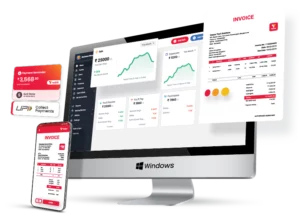
Expense Tracking:
With Accounting Software Vyapar, users can easily record their expenses and maintain a detailed log of all financial transactions. You can enter expenses manually or import them from other sources. It simplifies the process of data entry and ensures that all expenses are accurately recorded.
You can categorise expenses into different categories or custom labels based on your business needs. You can create expense categories such as office supplies, travel expenses, utilities, or any other relevant classification.
The Expense Management Software lets you attach relevant documents, such as receipts, invoices, or bills, to your expense records. This feature helps you maintain a complete audit trail and ensures you have all the necessary documentation for future reference or tax purposes.
The expense tracking feature in Vyapar accounting software simplifies the task of managing and analysing expenses for businesses. It promotes better financial control, ensures accurate record-keeping, and supports GST compliance.
Inventory Management:
Vyapar allows users to keep track of their inventory levels in real-time. You can record the initial stock quantity and update stock movements as you purchase or sell items. It lets you monitor the available stock at any given time.
With Inventory Management Software Vyapar, you can set reorder points for your inventory items. When stock levels reach the predefined threshold, the software alerts you to reorder those items. This proactive approach ensures that you maintain adequate stock levels.
Vyapar supports barcode and QR code scanner camera. It enables faster and more accurate inventory management. You can generate and print barcodes or QR codes for your products. OR codes make it easier to track and manage inventory by scanning them with a barcode scanner.
The software provides tools to calculate the value of your inventory accurately. Vyapar offers different methods for inventory valuation, such as FIFO (First-In, First-Out) or weighted average cost. It allows you to choose the method that suits your business needs.
Payment Reminders:
Vyapar lets users schedule automated payment reminders for their customers. Once set up, the software automatically sends reminders to clients on specified dates. It eliminates the need for manual follow-ups.
Vyapar offers flexibility in choosing reminder intervals. Users can set reminders to be sent before the due date, on the due date, or after a certain grace period. This ensures that customers receive timely reminders based on the business’s payment terms.
Vyapar allows payment reminders to be sent via various communication channels. You can send it via email, SMS, and instant messaging apps. This versatility ensures that businesses can reach their customers through their preferred mode of communication.
Users can monitor the status of each reminder and view whether a payment has been made or if further action is required. Businesses can maintain a professional image by sending automated, polite, and consistent reminders to their clients.
Data Backup And Sync:
Vyapar’s data backup feature ensures that your business data remains safe and secure. It enables users to create backups of their financial records. Businesses can protect against data loss due to hardware failure, system crashes, or other unforeseen events.
Vyapar simplifies the backup process by offering automatic backups. Users can schedule regular backups at predefined intervals, such as daily, weekly, or monthly.
Vyapar’s data sync feature ensures that your business data remains consistent across multiple devices. Whether you access Vyapar on your computer, smartphone, or tablet, the sync feature keeps all your data up to date in real time.
Vyapar’s data sync feature also enables offline access to your business data. Users can continue working on their accounting tasks even without an internet connection. Any modifications made offline are automatically synced with the cloud once the internet connection is restored.
Integration With Payment Gateways:
Vyapar’s integration with payment gateways simplifies the payment process for businesses. It allows users to generate professional invoices within the software. Customers can make payments directly through the integrated payment gateways.
Vyapar supports integration with various payment gateways, offering businesses multiple payment options. Whether it’s credit cards, debit cards, net banking, or digital wallets, Vyapar ensures that customers have the flexibility to choose their preferred payment method.
Vyapar’s integration with payment gateways automates the process of payment reconciliation. When a customer makes a payment through the integrated gateway, Vyapar automatically updates the payment status. This saves time and effort for businesses.
Vyapar’s integration with reputable payment gateways ensures the security of online transactions. The payment gateways used by Vyapar adhere to industry-standard security protocols. It provides encrypted and secure payment processing.
Financial Reports:
Vyapar offers a wide range of customisable financial reports that cater to various business needs. Users can generate reports such as profit and loss statements, balance sheets, cash flow statements, sales reports, expense reports, and more.
Vyapar’s financial report feature provides real-time reporting. As transactions are recorded in the software, the reports are automatically updated. It enables users to monitor their financial health and make informed decisions.
Vyapar’s financial reports are designed to provide a visual representation of data. It makes it easier to interpret and analyse financial information. Graphs, charts, and tables are utilised to present the data. This visual representation enhances the comprehension of financial trends, patterns, and comparisons.
Vyapar’s financial reports offer comprehensive insights into various aspects of the business’s financial performance. Users can analyse revenue, expenses, profitability, cash flow, debtors, creditors, inventory turnover, and other key financial metrics.
Frequently Asked Questions (FAQs’)
A profit and loss adjustment account is a financial statement that summarises the adjustments made to the profit and loss account of a business. It is commonly used in accounting to show the adjustments made to the net profit or loss of a company before it is distributed to the owners or shareholders.
The profit and loss adjustment account provides a clear picture of the adjustments made to the net profit or loss of a business. It allows the stakeholders to understand the reasons behind the changes in the financial position of the company and helps in assessing the true profitability of the business.
The profit and loss adjustment account format includes the following details:
Particulars
Amount
Gross Profit or loss
Total Adjustments
Net profit or loss after adjustments
The common adjustments may include
Depreciation of assets
Provision for bad debts
Provision for doubtful debts
Provision for income tax
Provision for warranty expenses
Provision for gratuity or pensions
A profit and loss adjustment account provides a detailed breakdown of these adjustments. It allows stakeholders to understand the impact of various factors on the financial performance of the company. On the other hand, a regular profit and loss account presents the overall revenue, expenses, and resulting net profit or loss without itemising the adjustments separately.




